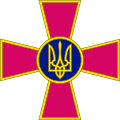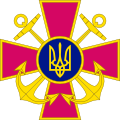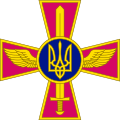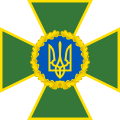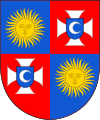Cross pattée

A cross pattée, cross patty, or cross paty, also known as a cross formy or cross formée (
Etymology
The word pattée is a
Variants
Several variants exist as follows:
| Image | Description |
|---|---|
 |
With the edges of the arms concave throughout. Best known for its use as the Iron Cross, based on the Leechkirche of the Teutonic Order (image), used as a symbol of the German Empire that was present in its War Ensign and war materiel, including on Luftstreitkräfte aircraft until April 1918 when the Balkenkreuz was introduced. |
 |
A cross pattée with a sharp point added to the lower limb, as if for use in staking into the ground, but used to represent a sword in the Cross of Saint James (also known as "sword cross"). [3] |
 |
With less curvature, used on Luftstreitkräfte aircraft until April 1918, and the basis for the similar cross used by the armed forces of modern Germany, the Bundeswehr. |
 |
Bolnisi cross, official national symbol of the republic of Georgia, used on flag, coat of arms and various official and unofficial organizations of this country. |
 |
With the ends of the arms convex and curved; sometimes called cross alisée (French: croix pattée alésée arrondie, lit. 'rounded reamed patté[4] cross'). |
 |
With triangular arms which come close to filling a square. One example is an artistic variant of the cross pattee components in the Sancroft arms, seen thrice in the ecclesiastical coat of arms of William Sancroft (1617-93), Archbishop of Canterbury in a mid-1740s stained glass at St Lawrence's Church, Mereworth. |
 |
With triangular arms that do not fill the square, used on flag, coat of arms and various medals, also known as the Saint George's Cross in Sweden and the Cossack cross in Ukraine. |
 |
With straight parallel lines at the centre, it still fits the general definition of "having branches that widen by curving at their ends",[4] and is considered pattée in Rudolf Koch's The Book of Signs[5] (German: Das Zeichenbuch). |
Use in crowns
Many
A cross pattée is particularly associated with crowns in Christian countries. It is often heavily jewelled, with diamonds and precious stones. The
Use by Crusaders, Prussia, and Germany
Teutonic Knights
This cross is often associated with the
-
Emblem of the Teutonic Order
Iron Cross
In 1813, King
Prussian and Imperial German Landwehr and Landsturm troops used a Cross Pattée cap badge to distinguish them from regular army troops. A stylized version of the Cross Pattée is used by the modern German military (Bundeswehr) as its symbol of nationality, and is found on vehicles, aircraft and publications, with no border of any kind at the ends of each arm (as was the case with the Balkenkreuz used on German aircraft in 1918-1945).
-
German Iron Cross, World War I
-
Modern Bundeswehr emblem
Modern usage
Belarus
The cross pattée is adopted in several municipal coats of arms of Belarus.
Canada
The cross pattée, a traditional Royal symbol in Canada,
-
Arms of Canada (1957 rendition)
-
Coat of arms of Québec
-
Badge of the Canadian Forces
-
Order of Merit
France
The cross pattée can be found on coats of arms of various French communes.
-
Coat of arms of Ambacourt
-
Coat of arms of Damouzy
-
Coat of arms of Fontaine-lès-Luxeuil
-
Coat of arms of Fontaines-Saint-Martin
-
Coat of arms of Saint-Gondon
Georgia
The Bolnisi cross (Georgian: ბოლნისის ჯვარი bolnisis ǰvari) is a cross symbol, taken from a 5th-century ornament at the Bolnisi Sioni church, which came to be used as one of the oldest national symbol of Georgia. It was used on the flags and coat of arms of the Kingdom of Georgia and the current Republic of Georgia, with its various organizations and administrative divisions.
-
Bolnisi Sioni inscriptions. Oldest Georgian inscription that uses the Asomtavruli script, predating the modern Mkhedruli script, inside Georgia.
-
Coat of arms of Georgia
-
Roundel of theGeorgian Defense Forces
-
Coat of arms of the city of Bolnisi
Latvia
-
Coat of arms of the Brotherhood of Blackheads shown in the House of the Blackheads, Riga
-
Coat of arms of Ventspils
Montenegro
The Montenegrin cross-flag (
-
Flag of the Prince-Bishopric of Montenegro
-
Montenegrin flag used in the Battle of Vučji Do. The Н.I. initials indicate Prince Nicholas I. One of the most important historical Montenegrin flags.
-
Flag of Old Royal Capital Cetinje
-
Coat of arms of Nikšić Municipality
-
Modern Montenegrin Air Force roundel
-
Montenegrin Police Special Counter-Terrorist Unit Insignia
-
Flag of Montenegrins of Serbia
Poland
-
Coat of arms ofPodkarpackie Voivodeship
-
Coat of arms of Przemyśl
-
Coat of arms of Rzeszów
-
Coat of arms of Skierniewice
Portugal
The Portuguese heraldry makes a very common use of three variants of the cross pattée, the standard form (also as a variant of the Maltese cross proper, associated with the Knights Hospitaller), the Alisee form (associated with the Knights Templar) and the Order of Christ cross (associated with this order of chivalry and also used as one of main the National symbols of Portugal). These crosses are often present on the arms of the municipalities located in former domains of these orders.
-
Coat of arms of Paços de Ferreira
-
Coat of arms of Madeira
-
Roundel of the Portuguese Air Force
Russia
The cross pattée is adopted by Russian Border Service, it is also found on coats of arms of some Russian regions.
-
Emblem of the Border Service
-
Coat of arms of Kirov Oblast
-
Coat of Arms of Perm Krai
-
Coat of arms of Borisovka, Belgorod Oblast
The cross alisée version of the cross pattée, with rounded edges, has been used in Russia since the 19th century. This cross shape was used in the badges of the
-
Narodnoe Opolcheniye badge, 1903 version
Spain
-
Coat of arms of El Bierzo
-
Coat of arms of Mondoñedo
-
Coat of arms of Morcín
-
Coat of arms of Oviedo
-
Coat of arms of Priorat
-
Coat of arms of Sabiñánigo
-
Coat of arms of Sitges
-
Coat of arms of Villafáfila
Sweden
In
-
Flag of the Swedish Order of Freemasons
-
Coat of arms of the Swedish Order of Freemasons
Ukraine
In
Military
-
 Flag of the Zaporizhian Sich (16th-18th century) and Danubian Sich (17th-18th century)
Flag of the Zaporizhian Sich (16th-18th century) and Danubian Sich (17th-18th century) -
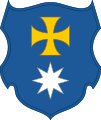 Coat of arms of the Myrhorod regiment of the Cossack Hetmanate (1625-1782)
Coat of arms of the Myrhorod regiment of the Cossack Hetmanate (1625-1782) -
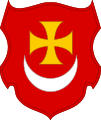 Coat of arms of the Borzna regiment of the Cossack Hetmanate (1648-1649)
Coat of arms of the Borzna regiment of the Cossack Hetmanate (1648-1649) -
 Coat of arms of the Ichnia regiment of the Cossack Hetmanate (1648-1649)
Coat of arms of the Ichnia regiment of the Cossack Hetmanate (1648-1649) -
 Coat of arms of the Braclav regiment of the Cossack Hetmanate (1648-1667)
Coat of arms of the Braclav regiment of the Cossack Hetmanate (1648-1667) -
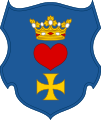 Coat of arms of the Kropyvna regiment of the Cossack Hetmanate (1649-1658)
Coat of arms of the Kropyvna regiment of the Cossack Hetmanate (1649-1658) -
 Coat of arms of the Zinkiv regiment of the Cossack Hetmanate (1671-1782)
Coat of arms of the Zinkiv regiment of the Cossack Hetmanate (1671-1782) -
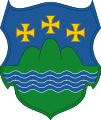 Coat of arms of the Bohuslav regiment of the Cossack Hetmanate (1685-1712)
Coat of arms of the Bohuslav regiment of the Cossack Hetmanate (1685-1712) -
 Cossack flags preserved from the time of the Khmelnytsky uprising (1651)
Cossack flags preserved from the time of the Khmelnytsky uprising (1651) -
 flag of theSloboda Cossacks(1651 – 1765)
flag of theSloboda Cossacks(1651 – 1765) -
 flag of theSloboda Cossacks(1688 – 1765)
flag of theSloboda Cossacks(1688 – 1765) -
 Flags and banners of theCatherine II)
Flags and banners of theCatherine II) -
 Portrait of theOtaman Yakiv Kukharenko featuring Black Sea Cossackbanners
Portrait of theOtaman Yakiv Kukharenko featuring Black Sea Cossackbanners -
Emblem of theMinistry of Defence of Ukraine
-
Emblem of the General Staff
-
Emblem of theDefence Intelligence
-
Emblem of theUkrainian Armed Forces
-
Emblem of the Ukrainian Ground Forces
-
Emblem of the Ukrainian Navy
-
Emblem of the Ukrainian Air Force
-
Emblem of the State Border Guard Service
-
Emblem of the Security Service of Ukraine
Volhynia
-
Coat of arms of the Volhynian Duchy (Principality)
-
Coat of arms of Volhynia with the Muscovite Monomakh's Cap
-
Volhynian Voivodeship in the Polish–Lithuanian Commonwealth
-
Coat of arms of the Russian Volhynian Vice-royaly (Namestnichestvo)
-
Coat of arms ofVolhynian Governorate
-
Volhynian Voivodeship in Poland (1920-1939)
-
Coat of arms of Rivne Oblast
-
Coat of arms of Zhytomyr Oblast
Eastern Podolia
-
Braclaw Voivodeship
Poltava (Myrhorod [Cossack] Cross)
-
Myrhorod city
United Kingdom
University of Durham
-
Coat of arms of the University of Durham
-
Coat of arms of St Mary's College, Durham
-
Coat of arms of St John's College, Durham
-
Coat of arms of Ustinov College, Durham
-
Coat of arms of the former College of St Hild, Durham
-
Coat of arms of the College of SS Hild and Bede, Durham
-
Coat of arms of John Snow College, Durham
-
Coat of arms of South College, Durham
United States
-
Southern Cross of Honor, used to honor Confederate Veterans
Other uses
The cross pattée is also placed before the name of the bishop who issues a Catholic imprimatur, and is occasionally found as a map symbol indicating the location of a Christian site.
It appears in the insignia of:
- The Victoria Cross
- The Distinguished Flying Cross (United States)
- The Bundeswehr Cross of Honour for Valour
- The Badge of Honour of the Bundeswehr
- The Order of St. George
- The Order "For Merit to the Fatherland"
- The Order of Bohdan Khmelnytsky
- The Order of the Dannebrog
- The Portuguese Football Federation
- F.C. Paços de Ferreira, a Portuguese football club
- C.F. Os Belenenses, a Lisboeta football club
- Casa Pia A.C., a Portuguese sports association
- Mira Mar SC, a Portuguese football club
- Flag of Asturias, a Spanish Principality
- Toulouse FC, a French football club
- The Sir Knight, Geneva Glen Camp's Highest rank in the orders
- The Knights of Columbus, designed in 1883, and called a "cross formée"
- Independent Truck Company, a manufacturer of skating equipment (in the alisée form, with the ends of the arms in the shape of arcs of an enclosing circle)
- The Crossmen Drum and Bugle Corps
- Schneider Cams, a speed equipment manufacturer
- Club de Regatas Vasco da Gama, a South African sports club
- Club de Regatas Vasco da Gama, a Brazilian sports club
- Neath RFC, a Welsh rugby club
- The Eaton House Group of Schools
- FC Volyn Lutsk, a Ukrainian football club
- Black Label Society, a heavy metal band
- Flag of the Hispanic People
- The Fifth Corps, a unit of the Union Army of the Potomac during the American Civil War from 1862–1865.
Encoding
In
The character "X" is rendered as a cross pattée in the Microsoft Wingdings font.
See also
References
- ^ Larousse Dictionnaire de la Langue Francaise Lexis, Paris, 1993, p.1356
- ^ Planché, J.R. The Pursuivant of Arms; or Heraldry Founded upon Facts. London, 1859, p.29
- ISBN 9781136410253.
- ^ a b "PATTÉ : Définition de PATTÉ". Centre National de Ressources Textualles et Lexicales. 2012. Archived from the original on 2023-08-11. Retrieved 2023-08-11.
- OCLC 509534.
- ^ Healey, T. (1977). The Symbolism of the Cross in Sacred and Secular Art. Leonardo, 10(4), 289-294. doi:10.2307/1573764
- ^ "Arms & Badges - Royal Arms of Canada, A Brief History". www.heraldry.ca.
- ^ Defence, National (November 2, 2018). "Canadian Medals Chart". aem.
- ^ Cetinje, Official website (English). "Symbols". Retrieved 18 April 2014.
- ^ Derevyanko, Kolesnikov. "Awards: Rewarded With A Battle Order", Bratishka, Feb 2002
- ^ Goncharov, 2010, Award System of the Russian Federation
- ^ Samoilov, 2021, "Military Expert Explains the Symbolism of the Trench Cross", Politnavigator
- ^ Nationalencyklopedin, "Georgskors", retrieved 12 August 2010. Swedish.
- ^ Norrgård, Leif (2009-02-18), "Frimurarkorset – symbol med dunkelt ursprung", Frimuraren (in Swedish), no. 1, Swedish Order of Freemasons, pp. 31–32, 1651-35766, archived from the original on 2016-08-18, retrieved 3 February 2015.






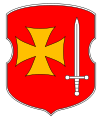






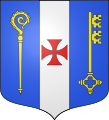

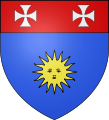



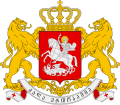



























![Medal "For Bravery" [ru]](http://upload.wikimedia.org/wikipedia/commons/thumb/c/c7/Medal_%22For_Bravery%22_1st_%D0%A1lass_%28Russia%29.png/67px-Medal_%22For_Bravery%22_1st_%D0%A1lass_%28Russia%29.png)



























